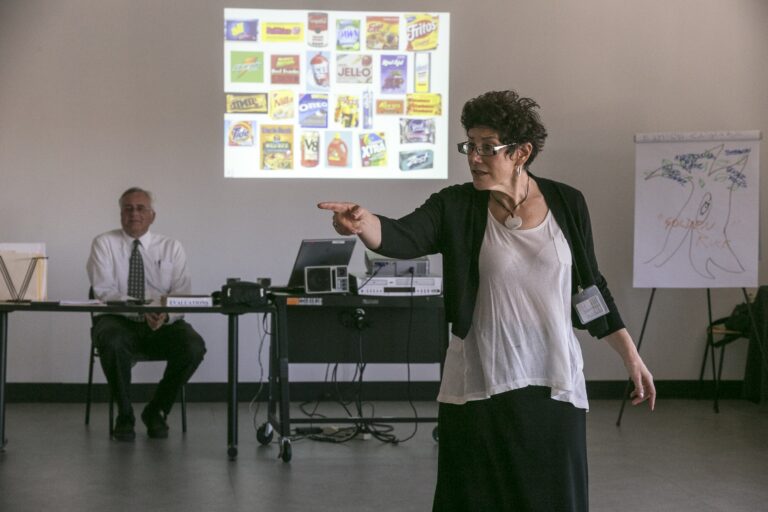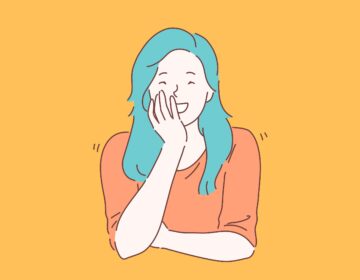Can you train people to be less biased?
Seminars and workshops on implicit bias promise to change cultures at police departments, organizations and universities. But how effective are these trainings?
Listen 8:55
In this Feb. 11, 2015, photo, veteran LAPD officers Don Wynne, left, and Ann Bozzi instruct dozens of unidentified Los Angeles Police Department officers learn to recognize unconscious prejudices and how they can impact behaviors on the street at a class at the Museum of Tolerance in Los Angeles. The department, which expects to send more than 5,000 officers to the museum’s course in the next several years, is working to weave implicit bias lessons into existing training. (AP Photo/Damian Dovarganes)
This story is from The Pulse, a weekly health and science podcast.
Subscribe on Apple Podcasts, Stitcher or wherever you get your podcasts.
Andrea Lawful-Sanders has been doing implicit bias training around the country for years.
Once, she was working with a police district, and she shadowed a white officer for a day. Lawful-Sanders is Black Jamaican.
At the end of the day, she remembered he told her that “when you first came to us and you said that both your children graduated from college and that they had never been in trouble … I looked at you and said, `This can’t be true because I don’t know any people of color that are successful and doing well without somebody giving them a leg up.’”
She said she was actually encouraged by what he said, because it meant he was thinking through what he learned and trusted her enough to be vulnerable.
The officers liked her training so much, they asked their superintendent when she was coming back.
Protests were sparked around the world after police officers killed George Floyd, and Breonna Taylor. The NBA and WNBA went on strike. Protesters and local politicians removed statues of slave traders and figures from the Confederacy. Amid this pressure, companies said Black Lives Matter. They said that they are “committed to creating safe environments,” and that they “stand in solidarity with the Black community.”
A common solution is to offer implicit bias training to employees, school boards, local governments, and police departments. New Jersey Gov. Phil Murphy signed a law requiring the training for law enforcement.
Not all people see the need for such training, however. President Donald Trump called any training that mentions white privilege “divisive, anti-American propaganda” and asked all federal agencies to stop spending money on those contracts.
Lorie Fridell, a criminologist at the University of South Florida who helped develop training for police officers, said many are “somewhere between defensive and outright hostile … they think we are going to stand them all in front of the room and treat them all like racists.”
Fridell said her team gets around such skepticism by hiring retired or current police officers as trainers, and by saying that the training is about human bias, not police bias.
“This training is not going to cure a racist cop of animus toward minority groups, but it will inform the police officer with good intentions that every officer is a part of the problem of biased policing and a significant part of the solution,” Fridell said.
But does the training work? Can it lead to the kind of diverse and equitable environments companies now say they want?
Tony Greenwald, a psychologist at the University of Washington and one of the creators of the widely used implicit association test, said, “If the goal is training to eliminate implicit biases, there’s no evidence that that training works.”
Training offers education, he said: People can learn what implicit bias is and where it comes from — “enjoyable and educational, but by themselves they don’t solve the problem.”
Real change is structural, Greenwald said.
For example, implicit biases often come into play when people have to make quick decisions. Greenwald and his colleague Calvin Lai, a psychologist at Washington University in St. Louis and an expert on implicit bias, recently reviewed the research and found that’s one part of a solution.
“A lot of the strategies revolve around how to give yourself more time to think, and how to put guard rails on how you judge other people so that you’re less likely to act on your biases,” Lai said.
One-and-done training isn’t enough
Lawful-Sanders agreed. She said she requires her clients to do more than organize a few sessions.
“This work is too intentional, it is too precious, and it is too tenuous for you to say, ‘Well, I’m going to train you for half a day, and that’s the end of that.’ And every time someone calls me and says that’s what they want, then I tell them that you have the wrong trainer, because I can’t do it, you are wasting my time and your money.”
Lawful-Sanders said she works with companies and organizations for years, and the process includes policy and culture changes.
For example, at a school district, she would ask administrators to pull out all their policies on race, bullying … and sometimes they didn’t have any. She makes it clear that organizations have to examine every part of their culture.
However, structural changes, without training on why those changes are coming, might not solve the problem either, as one company found.
Subscribe to The Pulse
Paradigm, a diversity and inclusion consulting firm, started out not doing implicit bias training, but working on changing systems and structures, like hiring processes, employee promotions, and performance management. As an example, founder and CEO Joelle Emerson said one way to reduce bias in job interviews is to have structure — writing specific questions that address the job for all candidates, and asking the people who decide whom to hire to justify why they think one person is better, rather than going by intuition, to avoid picking people like themselves.
“Maybe you have a form that you build, and it’s really thoughtfully designed and it’s prompting interviewers to give reasons for their decisions about a candidate. Well, if an interviewer doesn’t know why they’re being asked to use that form, and they just think that it’s an extra bureaucratic step or formality and they don’t use it, it’s not going to have the impact we want,” Emerson said.
Evelyn Carter, the social psychologist and training director at Paradigm, said the firm worked with one company that did the training and changed its recruitment process, but when it came to their take-home hiring exam, the people who came through were still almost all men.
“What they realized is that every single person who had contributed to creating the take-home exam was a man, every single person who was a grader on it was a man, and they only gave candidates a few hours to turn around the response to the take-home,” Carter said.
“I’m not saying that men cannot create a good take-home exam,” she said, “but what I am saying is that for this organization, what they realized was that they had narrowed the input of who was creating these processes to such a homogenous group that it makes sense that the output was that only homogenous groups of people were the ones that were making it to the other end of that stage.”
Test makers shape tests with their own knowledge and background. After decades of research on intelligence tests, for example, psychologists say it is practically impossible to design one that is free of cultural bias.
Creating real change in the workplace
Patricia Jaimes, a Ph.D. candidate at Michigan State University who studies diversity, equity, and inclusion in the sciences, said organizations need to do more than just recruit more people from under-represented groups. She said this is a deficit model: “bring in these students, and they try to get them to assimilate and to acculturate to the dominant group … this has been useful to an extent, but there is this pipeline problem, where people are still leaving.”
She’s working on an alternative approach that draws on ideas from education professor Tara Yosso: looking at what people of non-dominant cultures bring to an institution like a university or a scientific field, and reshaping the dominant culture to appreciate those differences.
Changes like those sound big, and the issue is not a new one.
Psychologist Calvin Lai has studied implicit bias and what to do about it for years. But he said there’s hope that it isn’t just a passing fad this time.
“It is useful to think in terms of years and decades, rather than something that will change overnight,” Lai said. “Some of these inequalities are so embedded in the fabric of our society when it comes to things like generational inequalities in things like income and wealth, that there is no way they can be done overnight outside of an incredibly radical redistribution of income and wealth.”
“But at the same time,” Lai said, “there can be periods where there is dramatic change, and I think we’re living in one of those periods right now, where there have been a sea rise in increases in support for Black Lives Matter, in support for political changes, in beliefs in systemic racism and so on, that we haven’t seen in prior political moments like this one.”
WHYY is your source for fact-based, in-depth journalism and information. As a nonprofit organization, we rely on financial support from readers like you. Please give today.







